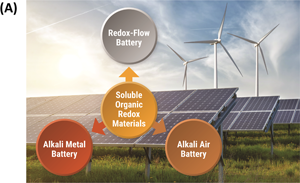Article contents
Emerging soluble organic redox materials for next-generation grid energy-storage applications
Published online by Cambridge University Press: 28 May 2020
Abstract

Because of their structural versatility, fast redox reactivity, high storage capacity, sustainability, and environmental friendliness, soluble organic redox molecules have emerged as materials that have potential for use in energy-storage systems. Considering these advantages, this paper reviews recent progress in implementing such materials in aqueous soluble organic redox flow batteries and organic alkali metal/air batteries. We identify and discuss major challenges associated with molecular structures, cell configurations, and electrochemical parameters. Hopefully, we provide a general guidance for the future development of soluble organic redox materials for emerging energy-storage devices used in the electricity grid.
Information
- Type
- Prospective Articles
- Information
- Copyright
- Copyright © Materials Research Society 2020
References
- 5
- Cited by

